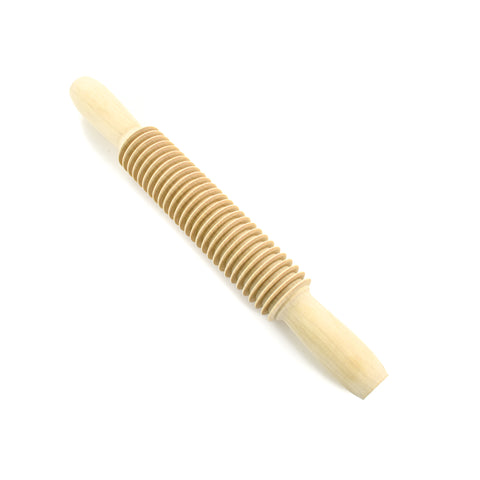The Buyer’s Guide to Rolling Pins
by Ellie Edwards

What are rolling pins?
A rolling pin is a kitchen utensil used to flatten pastry and doughs.
What are the different types of rolling pins?
Whether you’re rolling out fresh pasta, gingerbread dough or buckwheat pastry, there’s a rolling pin for you. These are the different types of rollings pins you can choose:
- A handled rolling pin - ideal for rolling out dough for biscuits and pastry tarts.
- A tapered rolling pin - for rolling out pizza doughs, sheets of fresh pasta and dumpling skins. The tapered design rolls dough more thinly and with greater control than a handled rolling pin.
- A ravioli rolling pin - with ridges to cut the ravioli into neat shapes.
- A tagliatelle rolling pin - designed to cut strips from sheets of fresh pasta.
- A springerle and speculaas biscuit roller - for creating traditional German and Dutch biscuits.
Which is the best rolling pin to buy?
Best rolling pin for avid bakers
This high-quality rolling pin has long, curved handles that are easy to grip. It is comfortably weighty and rolls smoothly on its metal axle with ball bearings at either end. This makes rolling very easy on the wrists as you barely need to apply any pressure – ideal for busy professionals doing lots of rolling every day.
Best rolling pin for home bakers
Best rolling pin for fresh pasta
This Italian tapered rolling pin, also known as a biconical rolling pin, is the traditional tool for rolling out pizza doughs and sheets of hand-made pasta. Instead of gripping this rolling pin at either end, rest the flat palms of your hand at either end to guide the rolling pin.
Best rolling pin for dumpling wrappers
This compact rolling pin is for rolling out dumpling wrappers for Japanese gyoza, Shanghai soup dumplings, Tibetan momos and Indian samosas. Instead of gripping this rolling pin at either end, rest the flat palms of your hand at either end to guide the rolling pin.
Best rolling pin for ravioli
Use this rolling pin to quickly and efficiently shape and seal ravioli from sheets of fresh pasta. Modelled on the original rolling tool used in Ligurian kitchens, the roller is crafted from beechwood making it hard and durable.
Best rolling pin for tagliatelle
Best rolling pin for German biscuits
Use this springerle & speculaas biscuit roller to quickly and easily mould traditional German and Dutch biscuits. The roller features 12 different designs of birds, flowers, berries, squirrels and prestigious buildings.
Frequently Asked Questions
What material is best for a rolling pin?
Wooden rolling pins are loved by bakers and cooks as they can be easily dusted with flour to prevent the dough sticking. Like chopping boards, wooden rolling pins are durable and long lasting if they are cared for correctly. To prevent cracking of the wood, simply coat the rolling pin in a neutral oil after use.
What are the different types of wood you can use for rolling pins?
Different types of wood have varying strengths, meaning certain rolling pins are better suited to certain jobs. Beech wood is the most popular choice for a classic rolling pin. It’s an affordable wood that has a good weight to it. It’s durable, meaning beech wood rolling pins can be used time and time again.
Hornbeam is a particularly strong and hard wood. This is ideal for spaghetti and tagliatelle rolling pins, as the ridges cut more cleanly than other woods, and will slice through pasta dough easily and precisely.
Pear wood has been used to make biscuit moulds and biscuit rolling pins since at least the 17th century. It has a very fine grain, which is essential when you want to carve intricate designs without splitting the wood.

About the author
Ellie Edwards is a food writer for Sous Chef. Previously she worked at olive magazine, writing about exciting new ingredients, UK restaurants and travelling the world to find the best cinnamon buns. When she's not exploring the likes of Belize, Kerala and Zanzibar, Ellie loves rustling up a feast in her London kitchen, with a particular passion for porridge, sourdough and negronis.







